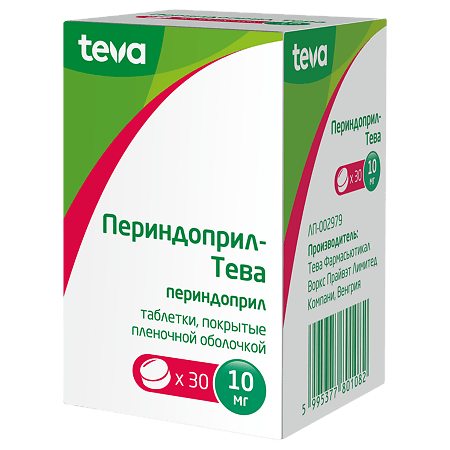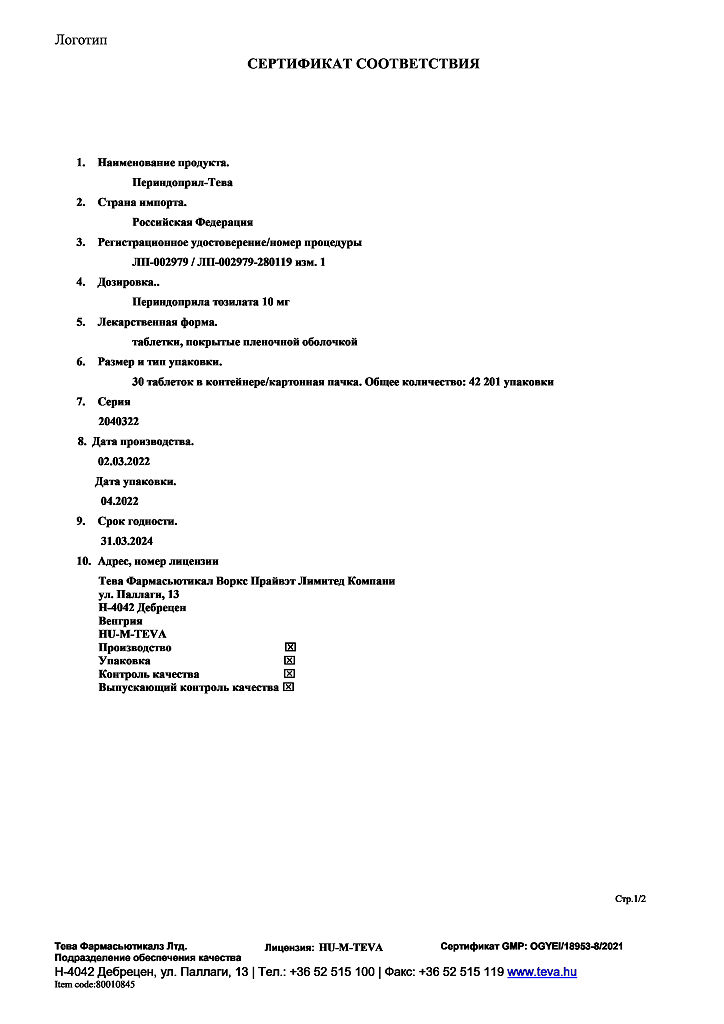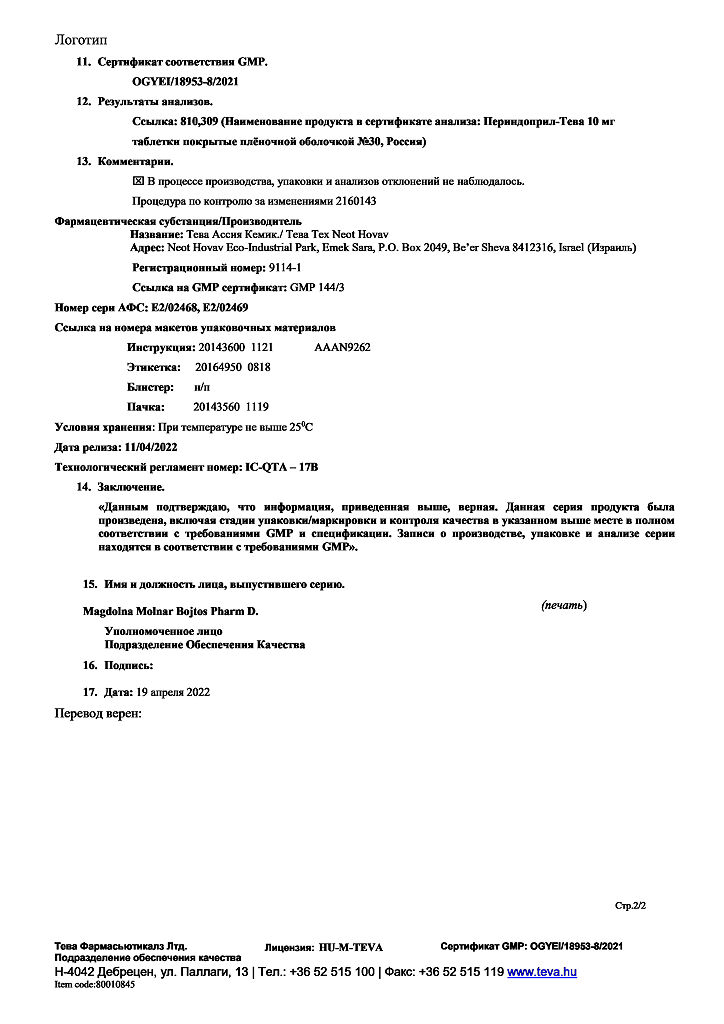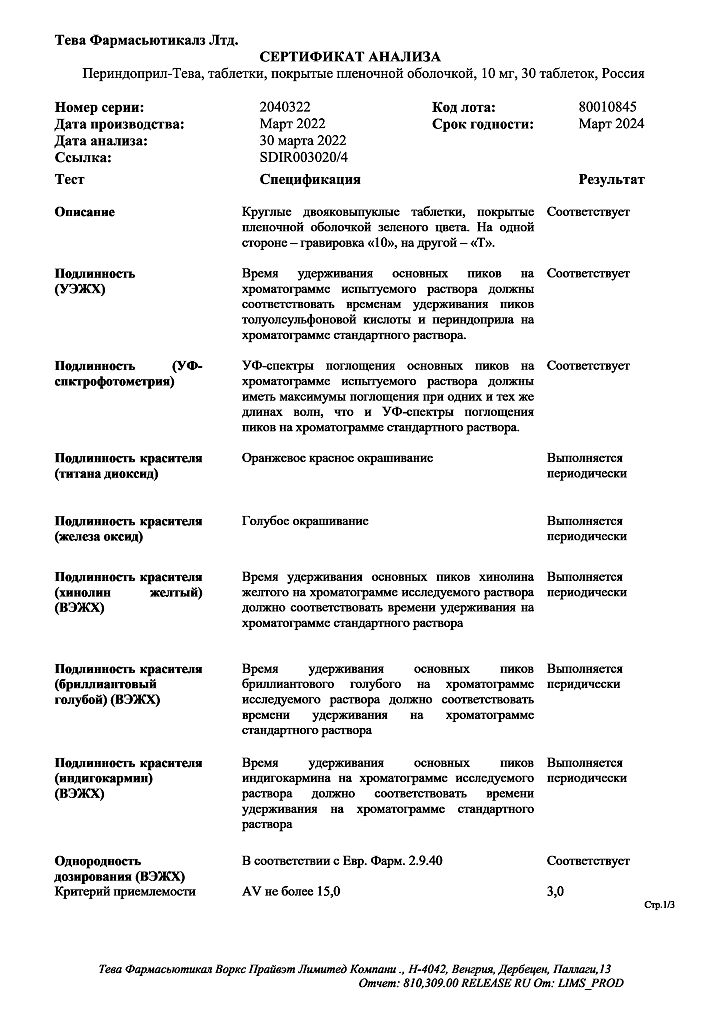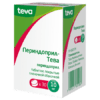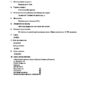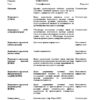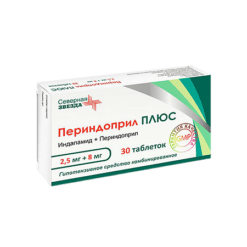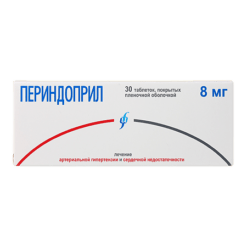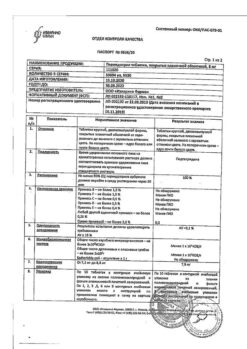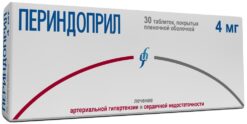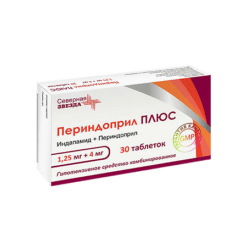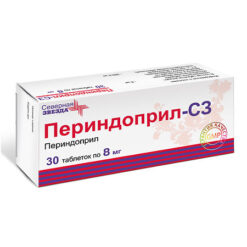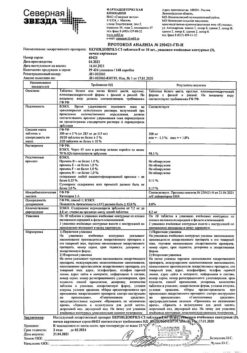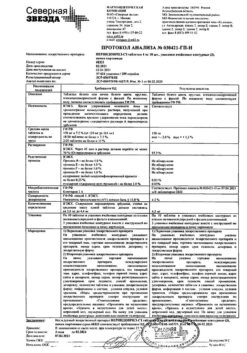No products in the cart.
Perindopril-Teva, 10 mg 30 pcs
€8.51 €7.09
Description
Pharmacotherapeutic group: inhibitor of angiotensin-converting enzyme (ACE)
Code ATX: C09AA04
Pharmacological properties
Pharmacodynamics
Mmechanism of action
Perindopril is an antihypertensive drug from the angiotensin-converting enzyme (ACE) inhibitor group. ACE (also called kininase II) is an exopeptidase that both converts angiotensin I into the vasoconstrictor angiotensin II and degrades bradykinin, which has a vasodilator effect, into an inactive heptapeptide. ACE inhibition leads to a decrease in plasma concentration of angiotensin II, which causes an increase in plasma renin activity (by a “negative feedback” mechanism) and a decrease in aldosterone secretion.
As angiotensin-converting enzyme inactivates bradykinin, ACE suppression is accompanied by an increase in both circulating and tissue kallikrein-kinin system activity, and the prostaglandin system is also activated. It is possible that this effect is part of the mechanism of antihypertensive action of ACE inhibitors, as well as the mechanism of development of some side effects of drugs of this class (e.g., cough).
Perindopril has a therapeutic effect due to the active metabolite perindoprilat. Other metabolites have no inhibitory effect against ACE in vitro.
Clinical efficacy and safety
Arterial hypertension
Perindopril is effective in the therapy of arterial hypertension of any severity. Both systolic and diastolic blood pressure (BP) decrease with the use of the drug at lying and standing position.
Perindopril decreases total peripheral vascular resistance (TPR) which leads to a decrease in BP, while peripheral blood flow is accelerated without changing heart rate (HR).
In general, perindopril causes an increase in renal blood flow without changing glomerular filtration rate.
The antihypertensive effect of the drug reaches its maximum 4-6 hours after a single oral dose and lasts for 24 hours. In 24 hours after oral administration there is significant (about 87-100%) residual ACE inhibition.
The decrease in BP is achieved fairly quickly. In patients with a positive response to treatment, BP normalization occurs within a month and persists without the development of tachyphylaxis.
The discontinuation of treatment is not accompanied by the development of “withdrawal” syndrome.
Perindopril has a vasodilator effect, helps to restore elasticity of large arteries and vascular wall structure of small arteries, and also reduces left ventricular hypertrophy.
The concomitant administration of thiazide diuretics increases the severity of the antihypertensive effect. In addition, concomitant use of ACE inhibitor and thiazide diuretic also decreases the risk of hypokalemia when taking diuretics.
Heart failure
Perindopril normalizes heart function by reducing preload and postload.
In patients with chronic heart failure who received perindopril, it was found:
- reduced filling pressures in the left and right ventricles of the heart;
- reduced total peripheral vascular resistance;
- increased cardiac output and increased cardiac index.
The study of perindopril compared to placebo showed that BP changes after the first perindopril administration in patients with chronic heart failure (NYHA functional class II-III), were not statistically significantly different from BP changes observed after placebo administration.
Cerebrovascular disease
. When perindopril tretbutylamine 2-4 mg/day (equivalent to 2.5-5 mg perindopril arginine or perindopril tosylate) is used both in monotherapy and in combination with indapamide, simultaneously with the standard therapy of stroke and/or arterial hypertension or other pathological conditions in patients with a history of cerebrovascular disease (stroke or transient ischemic attack) within the last 5 years, the risk of recurrent stroke (both ischemic and hemorrhagic nature) is significantly reduced. Additionally, the risk of fatal or disabling strokes; major cardiovascular complications, including fatal myocardial infarction; stroke-related dementia; and severe cognitive impairment are reduced.
These therapeutic benefits are seen in patients with both arterial hypertension and normal BP, regardless of age, gender, presence or absence of diabetes mellitus and type of stroke.
Stable coronary heart disease (CHD)
. Against the background of therapy with perindopril tretbutylamine 8 mg (equivalent to 10 mg perindopril arginine or perindopril tosylate) in patients with stable CHD there was a significant reduction of absolute risk of complications, provided by the main criterion of effectiveness (mortality from cardiovascular disease, frequency of nonfatal myocardial infarction and/or cardiac arrest with subsequent successful resuscitation) by 1.9%. Patients who had previously undergone a myocardial infarction or coronary revascularization procedure had a 2.2% reduction in absolute risk compared to the placebo group.
Double blockade of the renin-angiotensin-aldosterone system (RAAS)
There are data from clinical trials of combination therapy with an ACE inhibitor and an angiotensin II receptor antagonist (APA II).
There have been clinical studies involving patients with a history of cardiovascular or cerebrovascular disease or type 2 diabetes with confirmed target organ damage, as well as studies involving patients with type 2 diabetes and diabetic nephropathy.
The data from clinical trials showed no significant positive effect of combination therapy on the occurrence of renal and/or cardiovascular events and on mortality rates, while the risk of hyperglycemia, acute renal failure and/or arterial hypotension increased compared to monotherapy.
With consideration of the similar within-group pharmacodynamic properties of ACE inhibitors and ARA II inhibitors, these results would be expected for interactions between any other drugs in the ACE and ARA II classes.
Therefore, ACE inhibitors and ARA II should not be used concomitantly in patients with diabetic nephropathy.
There are data from a clinical trial investigating the beneficial effects of adding the direct renin inhibitor aliskiren to standard therapy with an ACE inhibitor or ARA II in patients with type 2 diabetes and chronic kidney disease or cardiovascular disease, or with a combination of these conditions. The study was terminated early due to an increased risk of adverse outcomes. Cardiovascular death and stroke occurred more frequently in the aliskiren group compared to the placebo group; also adverse events and serious adverse events (hyperkalemia, arterial hypotension, and impaired renal function) were reported more frequently in the aliskiren group than in the placebo group.
Pharmacokinetics
absorption. On oral administration, perindopril is rapidly absorbed in the gastrointestinal tract, the maximum concentration (Cmax) in plasma is reached after 1 hour. The elimination half-life (T1/2) of perindopril from blood plasma is 1 hour.
Perindopril has no pharmacological activity. Approximately 27% of the total amount of absorbed perindopril enters the bloodstream as the active metabolite perindoprilat. In addition to perindoprilat, 5 other metabolites without pharmacological activity are formed. Cmax of perindoprilat in blood plasma is reached 3-4 hours after oral administration.
Concomitant ingestion slows the conversion of perindopril to perindoprilat, thus affecting bioavailability. It has been shown that the relationship between perindopril dose and plasma concentrations is linear. Therefore, the drug should be taken orally once a day, in the morning, before meals.
Distribution. The volume of distribution of free perindoprilat is approximately 0.2 l/kg.
The binding of perindoprilat to plasma proteins, mainly ACE, is 20% and is dose-dependent.
Elevation. Perindoprilat is excreted by the kidneys. The T1/2 free fraction is 3-5 hours. “Effective” T1/2 is approximately 17 hours, the equilibrium state is reached within 4 days.
Special patient groups
The excretion of perindoprilat is delayed in the elderly and in patients with cardiac and renal insufficiency.
The dialysis clearance of perindoprilat is 70 ml/min.
In patients with cirrhosis, hepatic clearance of perindopril decreases by half. However, the amount of perindoprilat produced is not decreased, and no adjustment of the drug dose is required (see sections “Dosage and administration” and “Precautions”).
Indications
Indications
arterial hypertension;
chronic heart failure;
prevention of recurrent stroke (as part of complex therapy with indapamide) in patients with a history of cerebrovascular diseases (stroke or transient cerebral ischemic attack);
stable coronary artery disease: reducing the risk of developing cardiovascular complications in patients with stable coronary artery disease.
Pharmacological effect
Pharmacological effect
Pharmacotherapeutic group: angiotensin-converting enzyme (ACE) inhibitor
ATX code: C09AA04
Pharmacological properties
Pharmacodynamics
Mechanism of action
Perindopril is an antihypertensive drug from the group of angiotensin-converting enzyme (ACE) inhibitors. ACE (also called kininase II) is an exopeptidase that both converts angiotensin I into the vasoconstrictor angiotensin II and breaks down the vasodilator bradykinin into an inactive heptapeptide. ACE inhibition leads to a decrease in the concentration of angiotensin II in the blood plasma, which causes an increase in plasma renin activity (via a “negative feedback” mechanism) and a decrease in aldosterone secretion.
Because angiotensin-converting enzyme inactivates bradykinin, ACE suppression is accompanied by an increase in the activity of both the circulating and tissue kallikrein-kinin system, while the prostaglandin system is also activated. It is possible that this effect is part of the mechanism of the antihypertensive effect of ACE inhibitors, as well as the mechanism of development of some side effects of drugs of this class (for example, cough).
Perindopril has a therapeutic effect due to the active metabolite perindoprilat. Other metabolites do not have an ACE inhibitory effect in vitro.
Clinical efficacy and safety
Arterial hypertension
Perindopril is effective in the treatment of arterial hypertension of any severity. With the use of the drug, there is a decrease in both systolic and diastolic blood pressure (BP) in the patient’s “lying” and “standing” positions.
Perindopril reduces total peripheral vascular resistance (TPVR), which leads to a decrease in blood pressure, while peripheral blood flow accelerates without changing heart rate (HR).
As a rule, perindopril causes an increase in renal blood flow, but the glomerular filtration rate does not change.
The antihypertensive effect of the drug reaches its maximum 4-6 hours after a single oral dose and persists for 24 hours. 24 hours after oral administration, pronounced (about 87-100%) residual ACE inhibition is observed.
A decrease in blood pressure is achieved quite quickly. In patients with a positive response to treatment, normalization of blood pressure occurs within a month and is maintained without the development of tachyphylaxis.
Termination of treatment is not accompanied by the development of withdrawal syndrome.
Perindopril has a vasodilating effect, helps restore the elasticity of large arteries and the structure of the vascular wall of small arteries, and also reduces left ventricular hypertrophy.
The simultaneous administration of thiazide diuretics increases the severity of the antihypertensive effect. In addition, the simultaneous use of an ACE inhibitor and a thiazide diuretic also reduces the risk of developing hypokalemia while taking diuretics.
Heart failure
Perindopril normalizes heart function by reducing preload and afterload.
In patients with chronic heart failure treated with perindopril, the following was found:
decreased filling pressure in the left and right ventricles of the heart;
decrease in total peripheral vascular resistance;
increased cardiac output and increased cardiac index.
A study of perindopril compared with placebo showed that changes in blood pressure after the first dose of perindopril in patients with chronic heart failure (functional class II-III according to the NYHA classification) were not statistically significantly different from changes in blood pressure observed after taking placebo.
Cerebrovascular diseases
When using perindopril tertbutylamine 2-4 mg/day (equivalent to 2.5-5 mg perindopril arginine or perindopril tosylate) both in monotherapy and in combination with indapamide, simultaneously with standard therapy for stroke and/or arterial hypertension or other pathological conditions in patients with a history of cerebrovascular diseases (stroke or transient ischemic attack) over the past 5 years, the risk of recurrent stroke (both ischemic and hemorrhagic in nature) is significantly reduced. Additionally reduced: the risk of developing fatal or disabling strokes; major cardiovascular complications, including myocardial infarction, incl. with fatal outcome; stroke-related dementia; serious deterioration of cognitive functions.
These therapeutic benefits are observed in both patients with arterial hypertension and normal blood pressure, regardless of age, gender, presence or absence of diabetes mellitus and type of stroke.
Stable coronary heart disease (CHD)
During therapy with perindopril tert-butylamine 8 mg (equivalent to 10 mg of perindopril arginine or perindopril tosylate) in patients with stable coronary artery disease, there was a significant reduction in the absolute risk of complications provided for by the main effectiveness criterion (mortality from cardiovascular diseases, the incidence of non-fatal myocardial infarction and/or cardiac arrest with subsequent successful resuscitation) by 1.9%. In patients who had previously had a myocardial infarction or coronary revascularization procedure, the absolute risk reduction was 2.2% compared with the placebo group.
Dual blockade of the renin-angiotensin-aldosterone system (RAAS)
There are data from clinical studies of combination therapy using an ACE inhibitor and an angiotensin II receptor antagonist (APA II).
A clinical study was conducted in patients with a history of cardiovascular or cerebrovascular disease or type 2 diabetes mellitus accompanied by confirmed target organ damage, as well as studies in patients with type 2 diabetes mellitus and diabetic nephropathy.
Data from clinical studies did not reveal a significant positive effect of combination therapy on the occurrence of renal and/or cardiovascular events and on mortality rates, while the risk of hyperglycemia, acute renal failure and/or arterial hypotension increased compared with monotherapy.
Taking into account the similar intragroup pharmacodynamic properties of ACE inhibitors and ARA II, these results can be expected for the interaction of any other drugs, representatives of the ACE and ARA II classes.
Therefore, ACE inhibitors and ARB II should not be used simultaneously in patients with diabetic nephropathy.
There is evidence from a clinical trial examining the beneficial effects of adding the direct renin inhibitor aliskiren to standard therapy with an ACE inhibitor or angiotensin-converting enzyme II inhibitor in patients with type 2 diabetes mellitus and chronic kidney disease or cardiovascular disease, or a combination of these diseases. The study was stopped early due to an increased risk of adverse outcomes. Cardiovascular death and stroke were observed more often in the group of patients receiving aliskiren compared with the placebo group; Also, adverse events and serious adverse events (hyperkalemia, hypotension, and renal dysfunction) were reported more frequently in the aliskiren group than in the placebo group.
Pharmacokinetics
Suction. When taken orally, perindopril is rapidly absorbed from the gastrointestinal tract, the maximum concentration (Cmax) in blood plasma is reached after 1 hour. The half-life (T1/2) of perindopril from blood plasma is 1 hour.
Perindopril has no pharmacological activity. Approximately 27% of the total amount of absorbed perindopril enters the bloodstream in the form of the active metabolite perindoprilate. In addition to perindoprilate, 5 more metabolites are formed that do not have pharmacological activity. Cmax of perindoprilate in blood plasma is achieved 3-4 hours after oral administration.
Concomitant food intake slows down the conversion of perindopril to perindoprilat, thus affecting bioavailability. It has been shown that the relationship between the dose of perindopril and its concentration in blood plasma is linear. Therefore, the drug should be taken orally once a day, in the morning, before meals.
Distribution. The volume of distribution of free perindoprilate is approximately 0.2 l/kg.
The association of perindoprilate with plasma proteins, mainly with ACE, is 20% and is dose-dependent.
Excretion. Perindoprilat is excreted by the kidneys. T1/2 of the free fraction is 3-5 hours. “Effective” T1/2 is approximately 17 hours, the equilibrium state is achieved within 4 days.
Special patient groups
The elimination of perindoprilate is slowed in old age, as well as in patients with heart and renal failure.
The dialysis clearance of perindoprilate is 70 ml/min.
In patients with liver cirrhosis, the hepatic clearance of perindopril is reduced by 2 times. However, the amount of perindoprilate formed does not decrease, and no dose adjustment of the drug is required (see sections “Dosage and Administration” and “Special Instructions”).
Special instructions
Special instructions
Stable ischemic heart disease
If an episode of unstable angina (significant or not) develops during the first month of therapy with Perindopril-Teva, it is necessary to assess the benefit/risk ratio of therapy with this drug.
Arterial hypotension
ACE inhibitors can cause a sharp decrease in blood pressure. In patients with uncomplicated hypertension, symptomatic hypotension rarely occurs after the first dose. The risk of excessive reduction in blood pressure is increased in patients with reduced blood volume during diuretic therapy, while following a strict salt-free diet, hemodialysis, as well as with diarrhea or vomiting, or with severe renin-dependent arterial hypertension. Severe arterial hypotension was observed in patients with severe CHF, both in the presence of concomitant renal failure and in its absence. The most common arterial hypotension can develop in patients with more severe CHF, taking loop diuretics in high doses, as well as against the background of hyponatremia or renal failure. Close medical monitoring is recommended for these patients during initiation of therapy and during dosage titration. The same applies to patients with coronary artery disease or cerebrovascular diseases, in whom an excessive decrease in blood pressure can lead to myocardial infarction or cerebrovascular complications.
If arterial hypotension develops, it is necessary to place the patient in a horizontal position with raised legs and, if necessary, administer a 0.9% sodium chloride solution intravenously to increase blood volume. Transient arterial hypotension is not a contraindication for further therapy. After restoration of blood volume and blood pressure, treatment can be continued subject to careful selection of the dose of the drug.
In some patients with CHF and normal or low blood pressure, an additional decrease in blood pressure may occur during therapy with Perindopril-Teva. This effect is expected and is usually not a reason to discontinue the drug. If arterial hypotension is accompanied by clinical manifestations, it may be necessary to reduce the dose or discontinue Perindopril-Teva.
Renal dysfunction
In patients with renal failure (creatinine clearance less than 60 ml/min), the initial dose of Perindopril-Teva should be adjusted in accordance with the clinical clearance (see section “Method of administration and dosage”) and then depending on the therapeutic response. For such patients, regular monitoring of potassium levels and serum creatinine concentrations is necessary.
In patients with symptomatic heart failure, arterial hypotension that develops during the initial period of therapy with ACE inhibitors can lead to deterioration of renal function. Cases of acute renal failure, usually reversible, have sometimes been reported in such patients.
In some patients with bilateral renal artery stenosis or renal artery stenosis of a solitary kidney (especially in the presence of renal failure), an increase in serum concentrations of urea and creatinine was observed during therapy with ACE inhibitors, which was reversible after discontinuation of therapy.
In patients with renovascular hypertension during therapy with ACE inhibitors, there is an increased risk of developing severe arterial hypotension and renal failure. Treatment of such patients should begin under close medical supervision, with small doses of the drug and with further adequate dose selection. During the first weeks of therapy with Perindopril-Teva, it is necessary to discontinue diuretics and regularly monitor renal function.
In some patients with arterial hypertension in the presence of previously undetected renal failure, especially with concomitant diuretic therapy, there was a slight and temporary increase in serum urea and creatinine concentrations. In this case, it is recommended to reduce the dose of Perindopril-Teva and/or discontinue the diuretic.
Hemodialysis patients
Several cases of persistent, life-threatening anaphylactic reactions have been reported in patients undergoing dialysis using high-flux membranes and concomitantly taking ACE inhibitors. If hemodialysis is necessary, a different type of membrane must be used.
Kidney transplant
There is no experience with the use of Perindopril-Teva in patients who have recently undergone kidney transplantation.
Hypersensitivity, angioedema
Rarely in patients taking ACE inhibitors, incl. perindopril, angioedema of the face, extremities, lips, tongue, vocal folds and/or larynx developed. In patients taking mTOR inhibitors concomitantly, the risk of angioedema may be increased. This condition can develop at any time during treatment. If angioedema develops, treatment should be stopped immediately, and the patient should be under medical supervision until symptoms disappear completely. Angioedema of the lips and face usually does not require treatment; Antihistamines can be used to reduce the severity of symptoms. Angioedema of the tongue, vocal folds, or larynx can be fatal. If angioedema develops, it is necessary to immediately administer epinephrine (adrenaline) subcutaneously and ensure airway patency.
Patients with a history of angioedema not associated with the use of ACE inhibitors may be at high risk of developing angioedema while taking an ACE inhibitor.
In rare cases, angioedema of the intestine develops during therapy with ACE inhibitors. In this case, patients experience abdominal pain as an isolated symptom or in combination with nausea and vomiting, in some cases without previous angioedema of the face and with normal levels of C1-esterase. Diagnosis was made using abdominal computed tomography, ultrasound, or surgery. Symptoms disappeared after stopping ACE inhibitors; when carrying out differential diagnosis, it is necessary to take into account the possibility of developing angioedema of the intestine (see section “Side effects”).
Anaphylactoid reactions during low-density lipoprotein apheresis (LDL apheresis)
In patients prescribed ACE inhibitors during the procedure of LDL apheresis using dextran sulfate, in rare cases, an anaphylactic reaction may develop. It is recommended to temporarily discontinue the ACE inhibitor before each apheresis procedure.
Anaphylactic reactions during desensitization
In patients receiving ACE inhibitors during a course of desensitization (for example, hymenoptera venom), in very rare cases, life-threatening anaphylactic reactions may develop. It is recommended to temporarily discontinue the ACE inhibitor before each desensitization procedure.
Liver failure
During therapy with ACE inhibitors, it is sometimes possible to develop a syndrome that begins with cholestatic jaundice and then progresses to fulminant liver necrosis, sometimes with death. The mechanism of development of this syndrome is unclear. If jaundice occurs or an increase in liver enzyme activity occurs while taking an ACE inhibitor, the ACE inhibitor should be discontinued immediately and the patient should be closely monitored. It is also necessary to conduct an appropriate examination.
Neutropenia, agranulocytosis, thrombocytopenia, anemia
Cases of neutropenia, agranulocytosis, thrombocytopenia and anemia have been reported in patients treated with ACE inhibitors. With normal renal function in the absence of other complications, neutropenia rarely develops. Perindopril-Teva should be used with great caution in patients with systemic connective tissue diseases (for example, SLE, scleroderma), simultaneously receiving immunosuppressive therapy, allopurinol or procainamide, as well as when combining all of these factors, especially with existing renal impairment. Such patients may develop severe infections that do not respond to intensive antibiotic therapy. When carrying out therapy with Perindopril-Teva in patients with the above factors, it is recommended to periodically monitor the number of leukocytes in the blood and warn the patient about the need to inform the doctor about the appearance of any symptoms of infection.
In patients with congenital deficiency of glucose-6-phosphate dehydrogenase, isolated cases of hemolytic anemia have been reported.
Negroid race
Like other ACE inhibitors, perindopril is less effective in lowering blood pressure in black patients, possibly due to the higher prevalence of low-renin conditions in this population of patients with arterial hypertension.
Cough
During therapy with ACE inhibitors, a persistent, non-productive cough may develop, which stops after discontinuation of the drug. This should be taken into account in the differential diagnosis of cough.
Surgery and general anesthesia
In patients whose condition requires major surgery or general anesthesia with drugs that cause hypotension, ACE inhibitors, including perindopril, may block the formation of angiotensin II with compensatory renin release. One day before surgery, therapy with ACE inhibitors must be discontinued. If the ACE inhibitor cannot be canceled, then arterial hypotension developing according to the described mechanism can be corrected by increasing the volume of blood volume.
Hyperkalemia
During therapy with ACE inhibitors, including perindopril, potassium levels in the blood may increase in some patients. The risk of hyperkalemia is increased in patients with renal and/or heart failure, advanced age (>70 years), decompensated diabetes mellitus, hypoaldosteronism, metabolic acidosis, dehydration, and in patients using potassium-sparing diuretics, potassium supplements, or other drugs that cause hyperkalemia (eg, heparin, co-trimoxazole (trimethoprim + sulfamethoxazole). If it is necessary to prescribe these drugs simultaneously, it is recommended to regularly monitor the level of potassium in the blood serum, since hyperkalemia can lead to arrhythmia, sometimes fatal.
Diabetes mellitus
In patients with diabetes mellitus taking oral hypoglycemic agents or insulin, blood glucose concentrations should be carefully monitored during the first few months of ACE inhibitor therapy.
Lactose
Perindopril-Teva tablets contain lactose. Therefore, patients with hereditary lactose intolerance, lactase deficiency or malabsorption syndrome should not take this drug.
Double blockade of the RAAS
Cases of hypotension, syncope, stroke, hyperkalemia and renal dysfunction (including acute renal failure) have been reported in susceptible patients, especially when used concomitantly with drugs that affect this system. Therefore, double blockade of the RAAS by combining an ACE inhibitor with ARAII or aliskiren is not recommended. The simultaneous use of ACE inhibitors with drugs containing aliskiren is contraindicated in patients with diabetes mellitus and/or with moderate or severe renal impairment (GFR less than 60 ml/min/1.73 m2 body surface area) and is not recommended in other patients.
Mitral stenosis/aortic stenosis/hypertrophic obstructive cardiomyopathy
Perindopril, like other ACE inhibitors, should be administered with caution to patients with left ventricular outflow tract obstruction (aortic stenosis, hypertrophic obstructive cardiomyopathy), as well as to patients with mitral stenosis.
Concomitant use of ACE inhibitors with ARB II is contraindicated in patients with diabetic nephropathy and is not recommended in other patients.
Impact on the ability to drive vehicles and machinery
It is necessary to take into account the possibility of developing arterial hypotension or dizziness, which may affect the ability to drive vehicles and work with technical equipment that requires increased concentration and speed of psychomotor reactions.
Active ingredient
Active ingredient
Perindopril
Composition
Composition
1 tab. – perindopril (in the form of tosylate) 10 mg
Excipients:
lactose monohydrate – 143.924 mg,
corn starch – 5.4 mg,
sodium bicarbonate – 3.172 mg,
pregelatinized corn starch – 14.4 mg,
povidone K30 – 3.6 mg,
magnesium stearate – 1.8 mg.
Shell composition:
opabray II green 85F210013 (partially hydrolyzed polyvinyl alcohol – 3.6 mg, titanium dioxide (E171) – 2.133 mg, macrogol-3350 – 1.818 mg, talc – 1.332 mg, indigo carmine (E132) – 0.0495 mg, brilliant blue dye (E133) – 0.0315 mg, iron oxide yellow dye (E172) – 0.018 mg, quinoline yellow dye (E104) – 0.018 mg).
Pregnancy
Pregnancy
Pregnancy
During pregnancy, the use of Perindopril-Teva is contraindicated. The drug should not be used in the first trimester of pregnancy, therefore, when planning pregnancy or diagnosing it, Perindopril-Teva should be discontinued as early as possible and other antihypertensive therapy should be carried out. There have been no adequate controlled studies of the use of ACE inhibitors in pregnant women. The limited available data on the effects of the drug in the first trimester of pregnancy indicate that the use of ACE inhibitors does not lead to fetal malformations associated with fetotoxicity. The drug Perindopril-Teva is contraindicated in the II-III trimesters of pregnancy, as it can cause fetotoxic effects in the fetus (decreased renal function, oligohydramnios, delayed ossification of the fetal skull bones) and neonatal toxic effects (renal failure, arterial hypotension, hyperkalemia). If, nevertheless, the drug was used in the II-III trimesters of pregnancy, then it is necessary to conduct an ultrasound examination of the kidneys and bones of the fetal skull.
Breastfeeding period
The use of Perindopril-Teva during breastfeeding is not recommended due to the lack of data on the possibility of its excretion into breast milk. If it is necessary to use the drug during lactation, you must stop breastfeeding.
Fertility
Preclinical studies have shown no effect of perindopril on reproductive function in rats of both sexes.
Contraindications
Contraindications
Hypersensitivity to perindopril or other components of the drug, as well as to other ACE inhibitors; pregnancy; breastfeeding period; history of angioedema (hereditary, idiopathic or angioedema due to taking ACE inhibitors); hereditary lactose intolerance, lactase deficiency or glucose-galactose malabsorption syndrome; age up to 18 years (efficacy and safety have not been established), simultaneous use with aliskiren and drugs containing aliskiren in patients with diabetes mellitus and/or moderate or severe renal impairment (glomerular filtration rate (GFR) <60 ml/min/1.73 m2 body surface area), simultaneous use with ARA II in patients with diabetic nephropathy.
With caution
Renovascular hypertension, bilateral renal artery stenosis, the presence of one functioning kidney, stenosis of the artery of a single kidney – the risk of developing severe arterial hypotension and renal failure; chronic heart failure (CHF) in the stage of decompensation, arterial hypotension; chronic renal failure (creatinine clearance (CC) less than 60 ml/min); hypovolemia and hyponatremia (due to a salt-free diet and/or previous diuretic therapy, dialysis, vomiting, diarrhea), cerebrovascular diseases (including cerebrovascular insufficiency, coronary artery disease, coronary insufficiency) – the risk of developing an excessive decrease in blood pressure; stenosis of the aortic or mitral valve, hypertrophic obstructive cardiomyopathy (HOCM), hemodialysis using high-flow polyacrylonitrile membranes – the risk of developing anaphylactoid reactions; condition after kidney transplantation – no experience of clinical use; before the procedure of low-density lipoprotein (LDL) apheresis, simultaneous desensitizing therapy with allergens (for example, hymenoptera venom) – the risk of developing anaphylactoid reactions; connective tissue diseases (including systemic lupus erythematosus (SLE), scleroderma), inhibition of bone marrow hematopoiesis while taking immunosuppressants, allopurinol or procainamide – the risk of developing agranulocytosis and neutropenia; congenital deficiency of glucose-6-phosphate dehydrogenase – isolated cases of hemolytic anemia; use in representatives of the Negroid race; surgical intervention (general anesthesia) – the risk of developing an excessive decrease in blood pressure; diabetes mellitus (control of blood glucose concentration); hyperkalemia; old age.
Side Effects
Side Effects
The frequency of adverse reactions listed below was determined in accordance with the recommendations of the World Health Organization: very often – at least 10%; often – at least 1%, but less than 10%; infrequently – not less than 0.1%, but less than 1%; rarely – not less than 0.01%, but less than 0.1%; very rarely – less than 0.01%, including individual messages; frequency unknown (cannot be calculated from available data).
From the central and peripheral nervous system: often – headache, dizziness, paresthesia, vertigo; uncommon – sleep disturbances, mood lability, drowsiness, fainting; very rarely – confusion.
From the side of the organ of vision: often – visual impairment.
From the organ of hearing: often – tinnitus.
From the cardiovascular system: often – a pronounced decrease in blood pressure; uncommon* – tachycardia, palpitations, vasculitis; very rarely – arrhythmias, angina pectoris, myocardial infarction or stroke, possibly secondary, due to severe arterial hypotension in high-risk patients.
From the respiratory system: often – cough, shortness of breath; infrequently – bronchospasm; very rarely – eosinophilic pneumonia, rhinitis.
From the digestive tract: often – nausea, vomiting, abdominal pain, dysgeusia, dyspepsia, diarrhea, constipation; infrequently – dryness of the oral mucosa; rarely – pancreatitis; very rarely – cytolytic or cholestatic hepatitis (see section “Special Instructions”), angioedema of the intestine.
From the skin: often – skin rash, itching; uncommon – angioedema of the face, upper and lower extremities, mucous membranes, tongue, vocal folds and/or larynx, photosensitivity, pemphigus, urticaria; rarely – worsening of psoriasis; very rarely – erythema multiforme.
From the musculoskeletal system: often – muscle cramps; infrequently – arthralgia, myalgia.
From the genitourinary system: infrequently – renal failure, erectile dysfunction; very rarely – acute renal failure.
General disorders: often – asthenia; uncommon – increased sweating, chest pain, peripheral edema, weakness, fever, falls.
From the hematopoietic organs and lymphatic system: infrequently* – eosinophilia, very rarely – decreased hemoglobin and hematocrit, thrombocytopenia, leukopenia/neutropenia, agranulocytosis, pancytopenia – hemolytic anemia (in patients with congenital deficiency of glucose-6-phosphate dehydrogenase).
Laboratory indicators: infrequently* – increased concentrations of urea and creatinine in blood plasma, hyperkalemia, reversible after discontinuation of the drug (especially in patients with renal failure, severe CHF and renovascular hypertension), hyponatremia, hypoglycemia; rarely – increased activity of liver enzymes and bilirubin in the blood serum.
*Evaluation of the frequency of adverse reactions identified by spontaneous reports was based on data from the results of clinical studies.
Interaction
Interaction
Drugs that cause hyperkalemia
Certain drugs or drugs of other pharmacological classes may increase the risk of developing hyperkalemia: aliskiren and aliskiren-containing drugs, potassium salts, potassium-sparing diuretics, ACE inhibitors, ARB II receptor antagonists, non-steroidal anti-inflammatory drugs (NSAIDs), Co-trimoxazole (trimethoprim + sulfamethoxazole) heparin, immunosuppressants such as cyclosporine or tacrolimus, trimethoprim. Combining these drugs increases the risk of hyperkalemia.
Concomitant use is contraindicated
Aliskiren
Patients with diabetes mellitus or impaired renal function (GFR < 60 ml/min/1.73 m2 body surface area) are at increased risk of hyperkalemia, deterioration of renal function, and increased incidence of cardiovascular morbidity and mortality.
Concomitant use is not recommended
Aliskiren
In patients without diabetes mellitus or renal impairment, there may be an increased risk of hyperkalemia, worsening renal function, and increased incidence of cardiovascular morbidity and mortality.
Double blockade of the RAAS
The literature has reported that in patients with established atherosclerotic disease, heart failure, or diabetes mellitus with end-organ damage, concomitant therapy with an ACE inhibitor and an ARB II is associated with a higher incidence of hypotension, syncope, hyperkalemia, and deterioration of renal function (including acute renal failure) compared with the use of only one drug that affects the RAAS. Dual blockade (for example, when combining an ACE inhibitor with an ARB II) should be limited to individual cases with careful monitoring of renal function, plasma potassium and blood pressure.
Estramustine
Concomitant use may result in an increased risk of adverse effects such as angioedema.
Neutral endopeptidase inhibitors (NEP)
An increased risk of angioedema has been reported with concomitant use of ACE inhibitors and racecadotril (an enkephalinase inhibitor used to treat acute diarrhea).
When ACE inhibitors are used simultaneously with drugs containing sacubitril (neprilysin inhibitor), the risk of developing angioedema increases, and therefore the simultaneous use of these drugs is contraindicated. ACE inhibitors should be prescribed no earlier than 36 hours after discontinuation of drugs containing sacubitril. Prescription of drugs containing sacubitril is contraindicated in patients receiving ACE inhibitors, as well as within 36 hours after discontinuation of ACE inhibitors.
Potassium-sparing diuretics (such as triampterene, amiloride), potassium supplements.
Typically, during therapy with ACE inhibitors, serum potassium levels remain within normal limits, but some patients may develop hyperkalemia. The combined use of ACE inhibitors and potassium-sparing diuretics (for example, spironolactone and its derivative eplerenone, triamterene or amiloride), potassium supplements can cause hyperkalemia (possibly fatal), especially if renal function is impaired (additional effects associated with hyperkalemia). Therefore, it is not recommended to combine perindopril with these drugs. These combinations should be prescribed only in case of hypokalemia, taking precautions and regularly monitoring serum potassium levels. Features of the use of spironolactone in heart failure are described below.
Lithium
With the simultaneous use of lithium preparations and ACE inhibitors, a reversible increase in the level of lithium in the blood serum and lithium toxicity may develop. The simultaneous use of ACE inhibitors with thiazide diuretics may further increase the level of lithium in the blood serum and increase the risk of developing its toxic effects. The simultaneous use of Perindopril-Teva and lithium preparations is not recommended. If such combination therapy is necessary, it is carried out under regular monitoring of the lithium content in the blood serum.
Concomitant use with medications requiring special caution
Potassium-sparing diuretics
Patients taking diuretics, especially those with excessive fluid and/or electrolyte excretion, may experience excessive hypotension when initiating ACE inhibitor therapy. The risk of an excessive decrease in blood pressure can be reduced by discontinuing the diuretic, intravenous administration of 0.9% sodium chloride solution, and by prescribing an ACE inhibitor in lower doses. Further increases in the dose of perindopril should be carried out with caution.
For arterial hypertension in patients receiving diuretics, especially when there is excessive excretion of fluid and/or electrolytes, diuretics should either be discontinued before starting the ACE inhibitor (in this case, a potassium-sparing diuretic can be reintroduced later), or the ACE inhibitor should be prescribed at a low dose and then gradually increase it.
When using diuretics in the case of CHF, an ACE inhibitor should be prescribed in a low dose, possibly after reducing the dose of a potassium-sparing diuretic used simultaneously.
In all cases, renal function (creatinine concentration) should be monitored in the first weeks of using ACE inhibitors.
Potassium-sparing diuretics (eplerenone, spironolactone)
Use of eplerenone or spironolactone in doses from 12.5 mg to 50 mg per day and low doses of ACE inhibitors:
When treating heart failure of functional class II-IV according to the NYHA classification with a left ventricular ejection fraction <40% and previously used ACE inhibitors and loop diuretics, there is a risk of hyperkalemia (with possible death), especially if the recommendations for this combination of drugs are not followed.
Before using this combination of drugs, you must ensure that there is no hyperkalemia and renal dysfunction.
It is recommended to regularly monitor the concentration of creatinine and potassium in the blood: weekly in the first month of treatment and monthly thereafter.
NSAIDs, including acetylsalicylic acid in doses of 3 g/day and above
The simultaneous use of ACE inhibitors and NSAIDs (acetylsalicylic acid in a dose that has an anti-inflammatory effect, cyclooxygenase-2 (COX-2) inhibitors and non-selective NSAIDs) may lead to a decrease in the antihypertensive effect of ACE inhibitors. Concomitant use of ACE inhibitors and NSAIDs may lead to deterioration of renal function, including the development of acute renal failure, and an increase in serum potassium, especially in patients with reduced renal function. Caution should be exercised when prescribing this combination, especially in elderly patients. Patients should receive adequate fluids, and close monitoring of renal function is recommended, both initially and during treatment.
Hypoglycemic agents
The simultaneous use of ACE inhibitors and hypoglycemic agents (insulin or oral hypoglycemic agents) can enhance the hypoglycemic effect, even leading to the development of hypoglycemia. As a rule, this phenomenon occurs in the first weeks of simultaneous therapy in patients with impaired renal function.
Baclofen
Enhances the antihypertensive effect of ACE inhibitors. Blood pressure levels and, if necessary, dosage of antihypertensive drugs should be carefully monitored.
Concomitant use with medications requiring some caution
Other antihypertensives and vasodilators
Concomitant use of perindopril with other antihypertensive drugs may enhance the antihypertensive effect of the drug. Concomitant use of nitroglycerin, other nitrates or vasodilators may lead to additional antihypertensive effects.
Acetylsalicylic acid, thrombolytic agents, beta-blockers and nitrates
Perindopril can be combined with acetylsalicylic acid (as an antiplatelet agent), thrombolytic agents and beta-blockers and/or nitrates.
Gliptins (linagliptin, saxagliptin, sitagliptin, vildagliptin)
Concomitant use with ACE inhibitors may increase the risk of developing angioedema due to the inhibition of dipeptidyl peptidase IV (DPP-IV) activity by gliptin.
mTOR (mammalian target of Rapamycin – target of rapamycin in mammalian cells) inhibitors – kinase inhibitors (sirolimus, everolimus, temsirolimus)
In patients taking mTOR inhibitors concomitantly, the risk of angioedema may be increased (see section “Special Instructions”).
Tricyclic antidepressants/antipsychotics (neuroleptics)/general anesthetics (general anesthetics)
Concomitant use with ACE inhibitors may lead to increased antihypertensive effect.
Sympathomimetics
Sympathomimetics may reduce the antihypertensive effect of ACE inhibitors. When using such a combination, the effectiveness of ACE inhibitors should be regularly assessed.
Gold preparations
When using ACE inhibitors, including perindopril, in patients receiving intravenous gold (sodium aurothiomalate), a symptom complex was described, including facial flushing, nausea, vomiting, and arterial hypotension.
When used simultaneously with myelotoxic drugs, the myelotoxic effect may be enhanced.
Overdose
Overdose
Symptoms: marked decrease in blood pressure, shock, stupor, bradycardia, water-electrolyte imbalance (hyperkalemia, hyponatremia), renal failure, hyperventilation, tachycardia, palpitations, dizziness, anxiety, cough.
Treatment: emergency measures are limited to removing the drug from the body: gastric lavage and/or taking activated charcoal, followed by restoration of water and electrolyte balance.
If there is a pronounced decrease in blood pressure, place the patient in a horizontal position with raised legs and take measures to replenish the circulating blood volume (CBV). With the development of severe bradycardia that is not amenable to drug therapy (including atropine), placement of a pacemaker is indicated. It is necessary to monitor vital signs and serum creatinine and electrolyte concentrations. Perindoprilat, the active metabolite of perindopril, can be removed from the systemic circulation by hemodialysis. The use of high-flow polyacrylonitrile membranes should be avoided.
Storage conditions
Storage conditions
Store at a temperature not exceeding 25 °C.
Keep out of the reach of children!
Shelf life
Shelf life
2 years.
Do not use after expiration date.
Manufacturer
Manufacturer
Teva Pharmaceutical Works Private Limited Company, Hungary
Additional information
| Shelf life | 2 years. Do not use after the expiration date. |
|---|---|
| Conditions of storage | Store at a temperature not exceeding 25 °C. Keep out of reach of children! |
| Manufacturer | Teva Pharmaceutical Works Production Limited Company, Hungary |
| Medication form | pills |
| Brand | Teva Pharmaceutical Works Production Limited Company |
Other forms…
Related products
Buy Perindopril-Teva, 10 mg 30 pcs with delivery to USA, UK, Europe and over 120 other countries.

